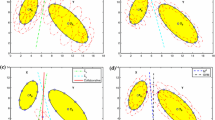Abstract
Inspired by the total margin algorithm, we extend balanced relative margin machine (BRMM) by introducing surplus variables, and propose a total margin based balanced relative (TM-BRMM). TMBRMM not only solves the loss of information points involved, but also addresses outliers at the outer boundaries that limit the maximum distance from points to separating hyperplane. Furthermore, by means of kernel function, it is easy to solve nonlinear separable datasets. The experiments on UCI datasets verify the feasibility and superiority of TM-BRMM.
Similar content being viewed by others
References
C. Cortes and V. Vapnik, “Support vector networks,” Mach. Learn. 20 (3), 273–297 (1995).
T. S. Furey, N. Cristianini, N. Duffy, et al., “Support vector machine classification and validation of cancer tissue samples using microarray expression data,” Bioinformatics 16 (10), 906–914 (2000).
X. F. Ling, J. Yang, and Y. E. Chen-Zhou, “Support vector machine-based human face recognition method,” Infrared Laser Eng. 5 (318–322), 327 (2001).
E. Osuna, R. Freund, and F. Girosi, “Training support vector machines: an application to face detection,” in Proc. CVPR (Hilton Head Island, SC, 2000), pp. 130–136.
H. C. Liu, M. A. Shu-Yuan, W. U. Ping-Dong, et al., “Handwritten digits recognition for automatic analysis system of UK psychology test,” J. Beijing Inst. Technol. 22 (5), 599–603 (1999).
L. M. Zeng and W. U. Xiang-Bin, “Research on SVM and its application of remote sense image classification for regions of interest,” Comput. Eng. Appl. 45 (6), 243–245 (2006).
Q. Chen, G. N. Cao, and L. Chen, “Application of support vector machine to atmospheric pollution prediction,” Comput. Technol. Develop. 32 (12), 61–65 (2010).
Y. Min, Y. Yun, and H. Nakayama, “A role of total margin in support vector machines,” in Proc. Int. Joint Conf. on Neural Networks (Portland, OR, 2003), Vol. 3, pp. 2049–2053.
H. L. Dai, “Class imbalance learning via a fuzzy total margin based support vector machine,” Appl. Soft Comput. C 31, 172–184 (2015).
Y. H. Liu and Y. T. Chen, “Face recognition using total margin-based adaptive fuzzy support vector machines,” IEEE Trans Neural Networks 18 (1), 178–192 (2007).
H. Pei, Y. Chen, Y. Wu, and P. Zhong, “Laplacian total margin support vector machine based on within-class scatter,” Knowledge-Based Syst. 119, 152–165 (2017).
P. K. Shivaswamy and T. Jebara, “Relative margin machines,” in Proc. Conf. on Neural Information Processing Systems (Vancouver, Dec. 2008), pp. 1481–1488.
Z. Y. Long, J. H. Liu, and L. U. Han yu, “Research of fuzzy ?-relative margin machine based on total margin,” Microelectron. Comput. 6, 167–171 (2012).
I. Kotsia and I. Patras, “Relative margin support tensor machines for gait and action recognition,” in Proc. ACM Int. Conf. on Image and Video Retrieval, CIVR (Xi’an, July 2010), pp. 446–453.
Y. Song, W. Zhu, Y. Xiao, and P. Zhong, “Robust relative margin support vector machines,” J. Algorithms Comput. Technol. 11 (2), 186–191 (2017).
V. Eidelman, Y. Marton, and P. Resnik, “Online relative margin maximization for statistical machine translation,” in Proc. Meeting of the Association for Computational Linguistics (Sofia, 2013), pp. 1116–1126.
A. B. Ashraf, S. Lucey, and T. Chen, “Reinterpreting the application of Gabor filters as a manipulation of the margin in linear support vector machines,” IEEE Trans. Software Eng. 32 (7), 1335–1341 (2010).
M. M. Krell, D. Feess, and S. Straube, “Balanced relative margin machine–the missing piece between FDA and SVM classification,” Pattern Recogn. Lett. 41 (1), 43–52 (2014).
Author information
Authors and Affiliations
Corresponding author
Additional information
The article is published in the original.
Yankun Wu was born in China, in 1998. She is majoring in Mathematics and Applied Mathematics in China Agricultural University, Beijing, China.
Huimin Pei was born in 1987 in China. She has received the B.S. degree from Linyi University in 2011, and the M.S. degree from Beijing University of Technology in 2014. Now she is a PhD. student in College of Science, China Agricultural University. Her research interests include machine learning and support vector machines.
Ping Zhong is a professor and PhD supervisor in College of Science, China Agricultural University. She has published many papers. Her research interests include machine learning and support vector machines.
Rights and permissions
About this article
Cite this article
Wu, Y., Pei, H. & Zhong, P. Total Margin Based Balanced Relative Margin Machine. Pattern Recognit. Image Anal. 28, 163–167 (2018). https://doi.org/10.1134/S1054661818010194
Received:
Published:
Issue Date:
DOI: https://doi.org/10.1134/S1054661818010194




